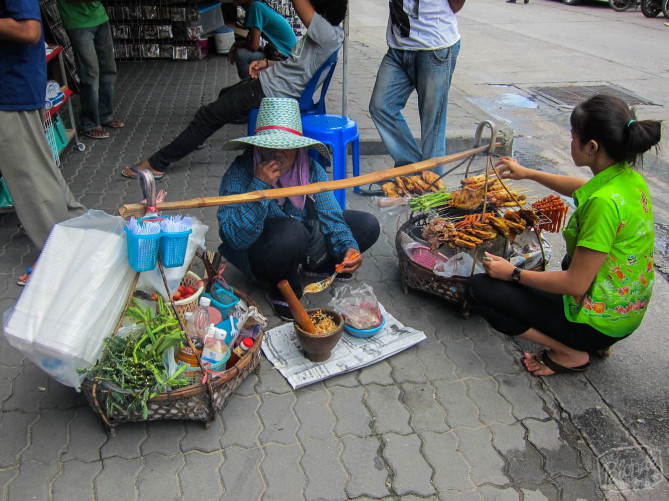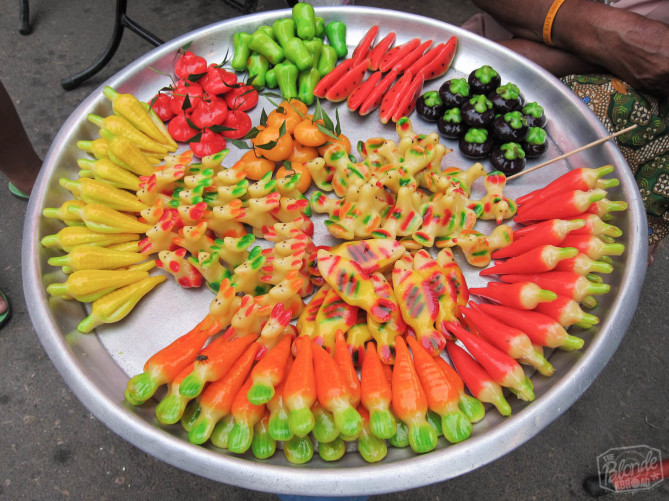Landing in Thailand, the sheer variety of street food can be both exciting and a little overwhelming. You might find yourself wondering about vibrant purple rice, mysterious fillings in banana leaves, and even how to tackle a whole fish on a stick!
Perhaps the thought, “Is that a fried cockroach?!” might even cross your mind.
Luckily, experiencing Thai street food is an essential and rewarding part of any trip to Thailand. This guide is designed to offer first-time visitors insights into the vibrant culture of Thai street food, helping you navigate the incredible flavors and experiences that await. While culinary specialties differ from region to region, understanding the basics will enrich your Thai adventure.
 Thailand Street food Vendor
Thailand Street food Vendor
Essential Tips for Enjoying Thai Street Food
One of the greatest appeals of Thai street food is its incredible affordability. Whether you are in bustling tourist hotspots or venturing into authentic local markets, street food remains incredibly budget-friendly. You can typically enjoy delicious and filling dishes from street vendors for as little as 30-60 baht, which translates to just $1-2 USD. Exploring street food is not only a culinary adventure but also a fantastic way to manage your travel budget effectively.
If you have a palate for heat, you might think you can handle “Thai spicy.” However, be prepared for a different level of intensity! “Thai spicy” is known for packing a significant punch. If you’re unsure of your tolerance, it’s wise to err on the side of caution. Consider ordering your dish “not spicy” or “mild” and then customize the heat level yourself with the provided chili sauces. This way, you can enjoy the flavors comfortably without being overwhelmed by excessive spiciness.
Speaking of customization, Thai food culture truly embraces personalization. When you sit down at a street food stall, you’ll often notice a condiment caddy on the table. These caddies are treasure troves of flavor enhancers, typically containing jars of sugar, fish sauce, a chili-garlic-vinegar sauce, and dried chili flakes. For an extra burst of authentic Thai flavor, ask for Nam Pla Prik. This potent concoction of fish sauce, chilies, garlic, and lime is a beloved staple and can elevate your street food experience to another level.
It’s worth noting that Thai cuisine can lean towards the sweeter side, sometimes surprisingly so. Drinks like Thai iced tea (cha yen) and Thai iced coffee are often prepared with a generous amount of sweetened condensed milk. If you prefer a less sweet beverage, don’t hesitate to request “little sweet” or “sweetness less” when ordering. You can always taste it first and add more sweetener if desired. Thai iced tea, with its creamy, orange hue and heavenly taste, is a must-try and a delightful departure from typical iced tea.
 IMG_3570
IMG_3570
For those with a sweet tooth, Thai desserts are a delightful adventure. You’ll encounter an array of colorful and creatively shaped sweets, some of which might not immediately register as desserts. Thai marzipan, for example, is crafted from mung beans and meticulously sculpted and painted to resemble miniature, glossy fruits and vegetables. Mango sticky rice, a classic Thai dessert, features sweet sticky rice drenched in coconut milk and served with slices of fresh, ripe mango. Another treat is sweet custard-topped rice, often presented as a charming little package wrapped in a banana leaf.
Understanding basic Thai eating etiquette can also enhance your street food experience. While Thailand is known as “The Land of Smiles,” it could also be called “The Land of Spoons” due to the prominent role of this utensil in dining. Remember a few key points: chopsticks are generally not used for Thai dishes, and knives are also uncommon at the table. The primary utensils are the fork and spoon, along with your fingers for certain foods. Traditionally, you use your fork to guide food onto your spoon, and then eat from the spoon. It’s also customary to eat sticky rice by forming it into bite-sized balls with your fingers, using your right hand.
 IMG_3433
IMG_3433
For the adventurous eater, Thai street food markets sometimes offer unique protein sources – bugs! While perhaps not for everyone, fried insects are a relatively common snack in Thailand. Giant water bugs, in particular, might catch your eye with their resemblance to large cockroaches. Interestingly, the essence of these water bugs is sometimes used to flavor Nam Pla Prik chili sauce. So, even if you’re hesitant to try them whole, you might be unknowingly enjoying their flavor in other dishes!
Finally, forget rigid meal categories when it comes to Thai food. The concept of distinct “breakfast,” “lunch,” and “dinner” foods is less defined in Thailand. While Western breakfasts might center around eggs, Thai breakfast options often include savory and satisfying choices like noodle soups or flavorful pork or beef with sticky rice, conveniently packaged in a plastic bag for takeaway. If soup for breakfast doesn’t appeal to you, fresh fruit, a refreshing fruit smoothie, or a revitalizing Thai iced coffee are always readily available as lighter morning options.
Exploring Street Food In Thailand is more than just eating; it’s an immersion into Thai culture and a feast for the senses. Embrace the adventure, be open to new flavors, and get ready to discover your favorite Thai street food dishes!

